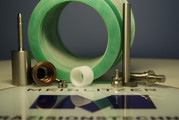As part of the research project OPtima a top-level consortium with the participation of PCCL aims to improve the production of plastic components for semiconductor machines.
Semiconductor machines and plastic parts
Semiconductor chips are needed to make cars safer,mobile phones smarter and consumer electronics moreuser-friendly. The manufacture of such semiconductors requires machines that also contain special plastic parts. And it is these parts that are critical. This is because semiconductor chips and the fabrication processes involved place extremely high demands on the components used in terms of accuracy, purity, material and surface quality. Inferior plastic parts have to be eliminated, cause waste and therefore also costs. What is particularly challenging here is detecting flaws and the tiniest inclusions that are no bigger than 0.25 mm². Current inspection devices may enable the geometry tolerances to be verified, but are not however capable of adequately determining the material or the type and structure of the inclusion detected. Many components with inclusions are therefore rejected as aprecaution. This delays the fabrication process and also gives rise to high costs. It is here that is the starting point for the OPtima research work.
Analysing processes
CTR physicist, area and project manager Christina Hirschl explains the challenge: “We aim to achieve several things in the project. Firstly, we need to systematically examine the inclusions and identify the causes. We then intend to use the results for improving the entire fabrication process in order to develop an automatic quality assurance procedure, which can be integrated in the fabrication process and comes close to achieving zero defects.” The first step will be to use micro-analytical methods for identifying the characteristics, structure and frequency of inclusions and their causes. Drawing on the results, a demonstrator will be built that can detect all three criteria – inclusion size, structure and material – in an environment of great product variety and dynamics. To achieve this, the team is systematically examining various different approaches such as optical, spectroscopic and acoustic detectionand test methods.
Resource-efficient manufacture
All the research work and demonstrator developments should lead to an improvement in resource and production efficiency in relationto raw materials, energy, operating time and waste prevention. If everything goes according to plan, the findings and results could also be used for other sectors, such as the food or medical technology industries, which also require high-purity plastic parts.
The "OPtima" project is co-funded by the research, technology and innovation (FTI) Initiative "Production der Zukunft", promoted from the Austrian Research Promotion Agency (FFG).
Project facts & figures
Title: OPtima - optimised production for polymer arts in semiconductor machine manufacture
Programme: Produktion der Zukunft
Programme coordinator: FFG Forschungsförderungsgesellschaft
Project lead: CTR Carinthian Tech Research AG
Duration: 2 years (04/2016 - 03/2018)
Partners:
- Lam research AG www.lamresearch.com/austria
- Meislitzer Präszisionstechnik GmbH www.feinmechanik.at
- Polymer Competence Center Leoben GmbH www.pccl.at
- CTR Carinthian Tech Research www.ctr.at
















